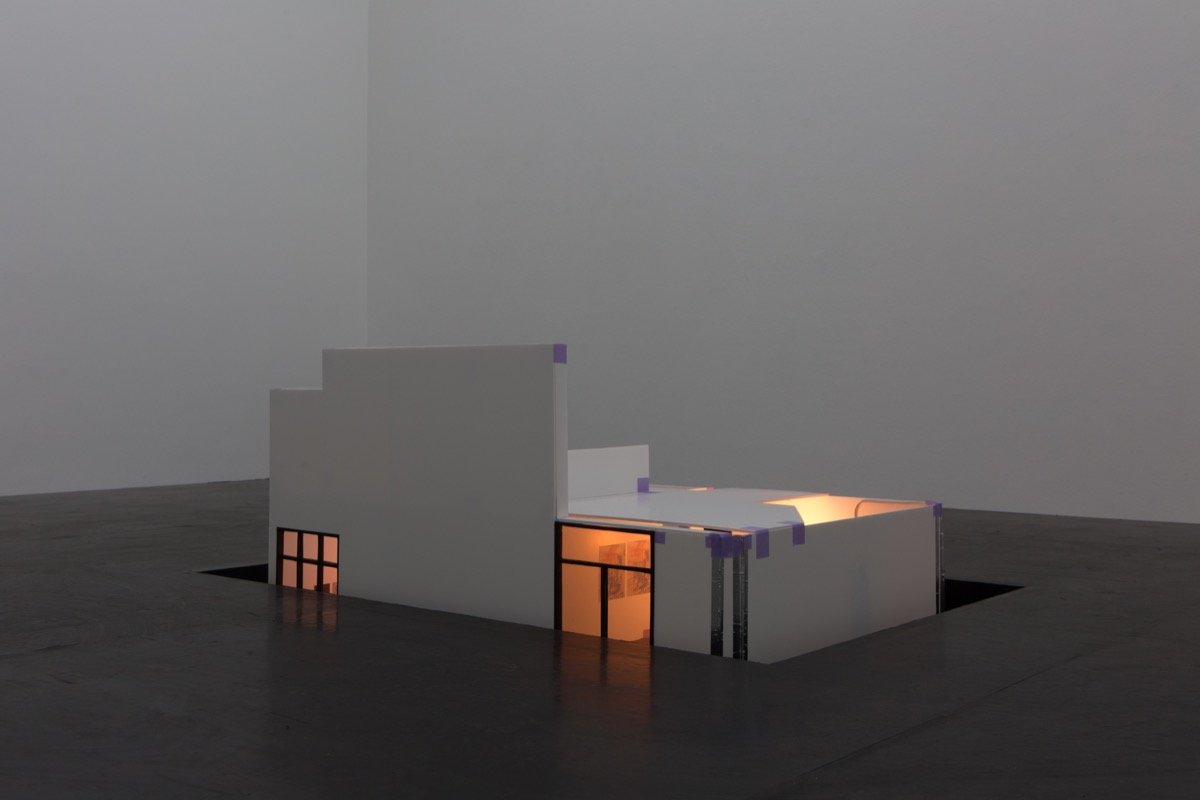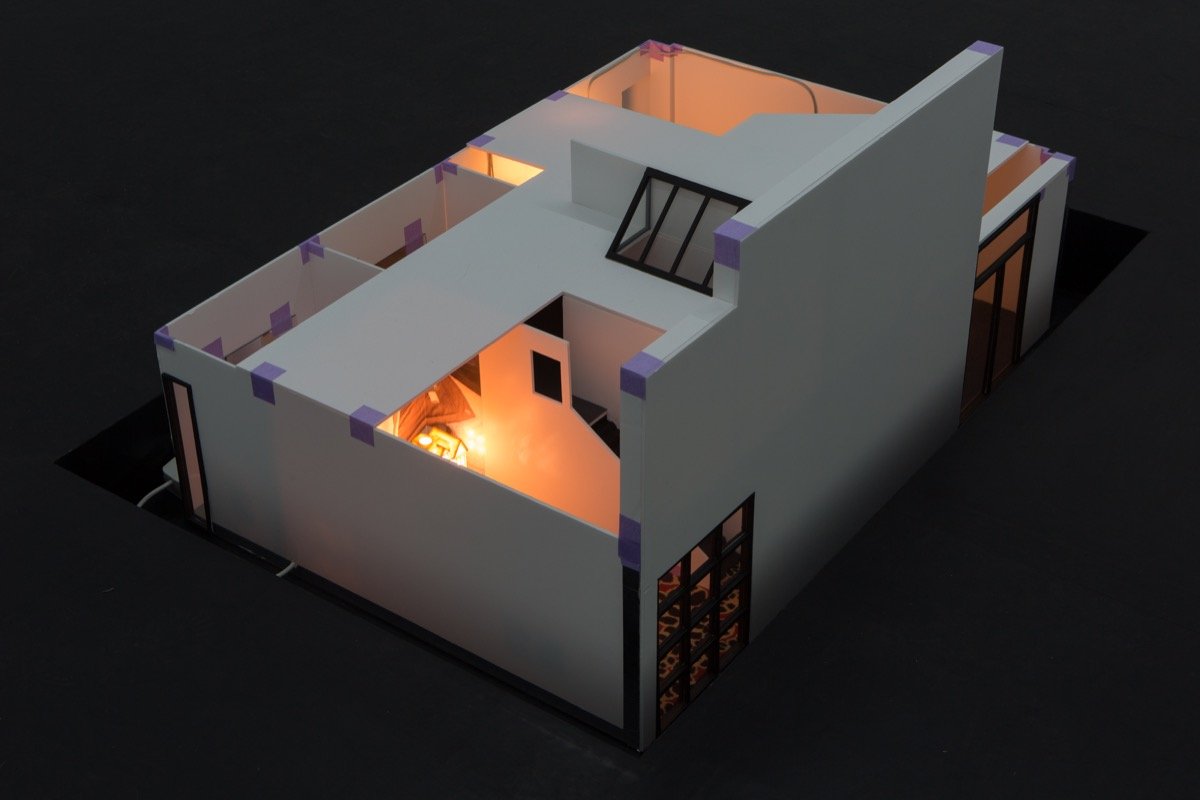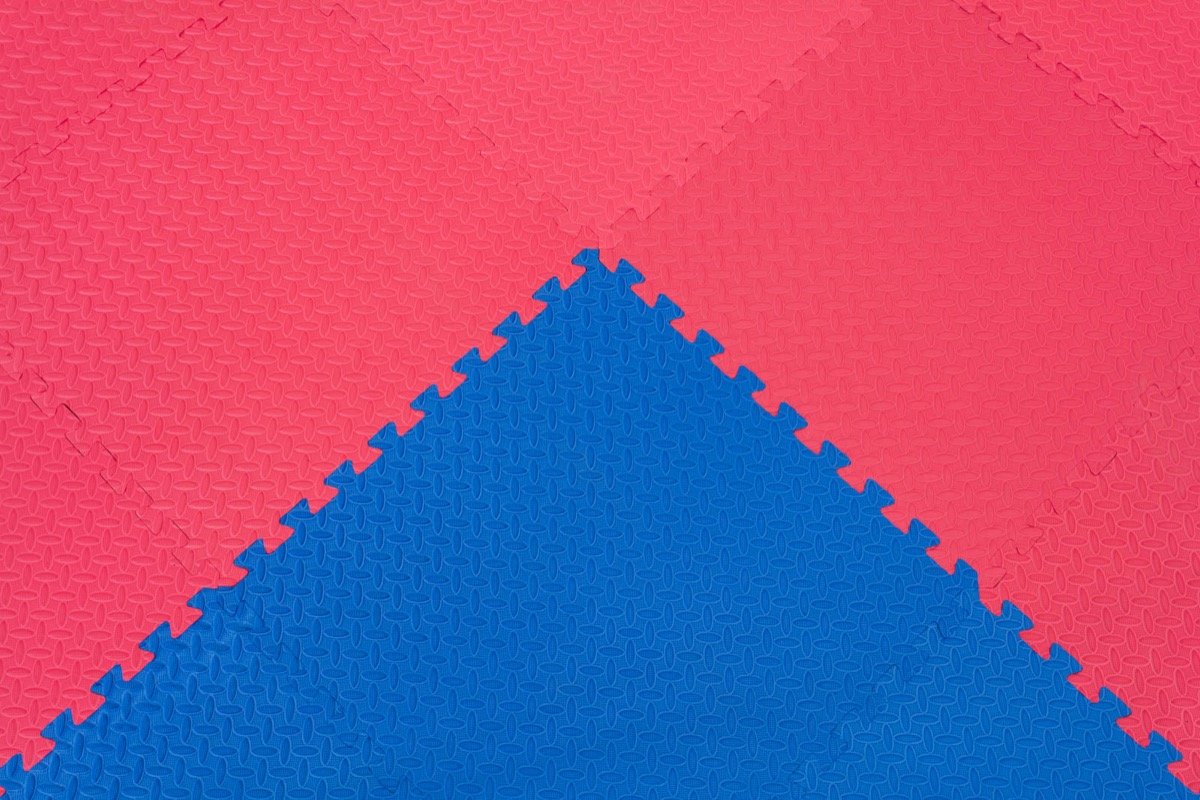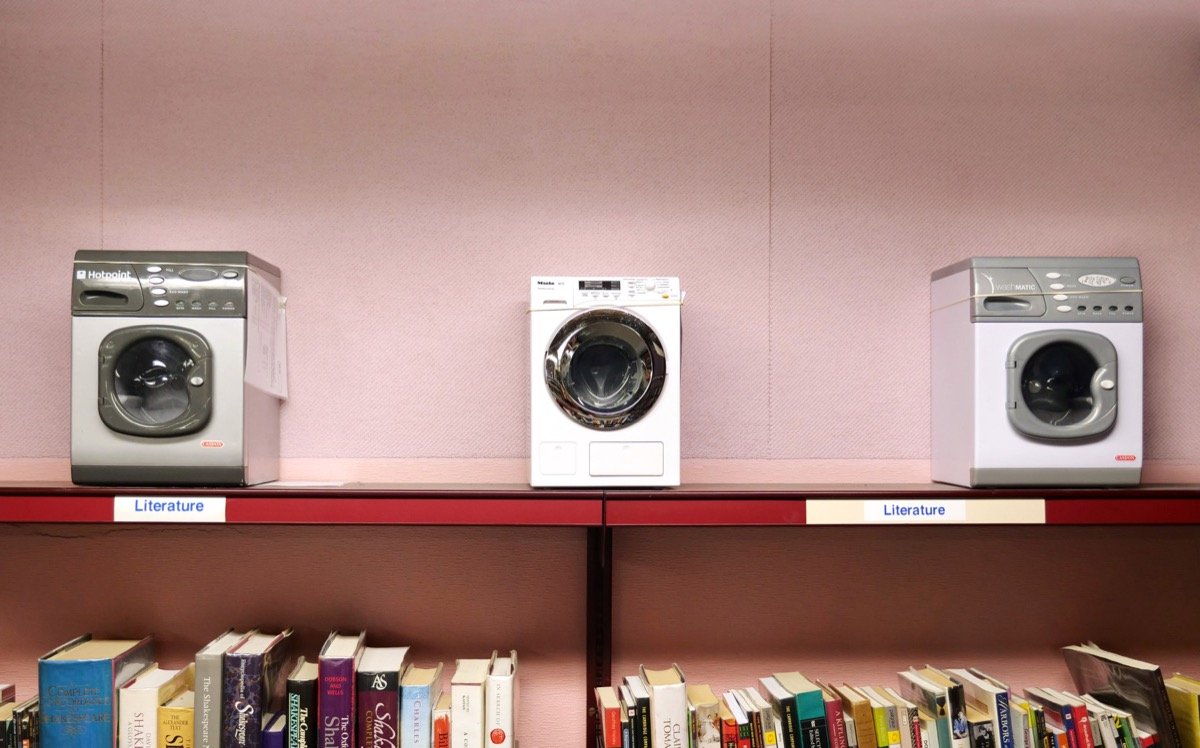Ghislaine Leung
0465773005
15 April - 6 June 2021

Carriages 2021
Carriage. Any size. The carriage must include shafts.
Mixed Sports 2021
Interlocking puzzle flooring tiles with proportional central square in complementary colours. No more than two colours of foam flooring tiles to be used.
The tiles must fill the exhibition floor area.
Blackouts 2021
Children’s blackout curtains, or blinds, over any window. The curtains should all be of the same fabric. Either all blinds or all curtains.
0465773005 2021
Title Sign
Writing and press
CANCELLATIONS
Noah Barker
Mousse Magazine, No. 65, Summer 2018, pp.54-59

London based artist and writer Ghislaine Leung speaks with Noah Barker about her recent works, material parity, constitutional critique, and her upcoming exhibition at Chisenhale, London.
NOAH BARKER
So we’re at a strange chess table in a modernist park above Houston in Manhattan. Maybe we can start with play? There’s a line in one of your text works, _190813, from 2015, “Playing in order to be seen to be playing. You play so well it seems exactly like playing to you.”
GHISLAINE LEUNG
Sure, there’s a general notion of play in relation to artifice or movement that, for me, historically relates to suspension, a can- celling out and creating a void or hole. I’ve written a lot on these kind of transitional moments, on falling, being in two states and in none. The quote you reference is excerpted from a longer text, Approximations included in the new collection of my writing Partners (2018). It came out of these transcription exercises I had been doing which produce this very literal form of writing, a sheer, weird mass of text. And a lot of my practice starts with this kind of material hoarding, trying not prejudge. It’s a way of removing of my own defensive bases for verification, my own self-policing, to work with more material parity.
NB
I pick up on suspension as a condition, perhaps it’s parallel to play or its meta-genre. And in mind I have two notions: prevention and levitation. These seem to coincide in the fall, or rather a just-before moment.
GL
Yes, prior to the ground, through the hole. The relationship between dissonance and consonance is quite important for me. To make a hole in something there has to be some material for that hole to be made in, which is a subtractive mode, it’s contingent. So in my work there is the hoarding and then there is the editing, the removals. I love what the writer Mary Robison said about being a subtractionist not a minimalist. Minimalism invokes precision, a certain economy, whereas subtractionism removes, it leaves these dirty looming tears. It’s editorially analogous to moving image.
NB
If you’re creating these holes and their circumstances or material, then the reception seems to be what is held in suspension. But the scene of this “you”, the reader, losing track of what is and is not one activity or its representation is very interesting. It recalls the desire for something like a reflexive framework, I’m thinking of a film in a film or the play in play, essentially a modernist apparatus to build in critical distance.
GL
I feel that we can never get far enough away to attain critical distance. I’m not sure that mode of reflection is what is needed right now, sometimes it feels like the equivalent of holding a mirror to a narcissist. I’m more interested in what it is to be too close to see something. Much of the efficacy of systemic forms of hierarchy is held in certain assumed and enacted structural neutralities, insidious and hidden in plain sight; from neoliberal values to the banalities of content provision. I’m interested in working with these strange, default materials that claim to be neutral and these removals that are in fact highly contingent; with how they are constituted and in turn constitute. I’ve been rolling the phrase constitutional critique around in my mouth for a few years now. I mean constitutional in terms of both the legislative and bodily, how these structures are written and embodied. And I mean critique in an immanent sense, my doubt and own position inclusive. Maybe that is where suspension comes in, and loss too, in terms of a critique it’s less reflective than diffractive, diffraction implying a bend from the singular to expanded.
NB
I take this constitutional rather than institutional directive to manifest in ways whereby aesthetic decisions aren’t made to illuminate institutional limitations but to express legislative standards. I’m thinking of your recent work 58 : 96 / 49 (2018) that features a children’s playhouse purchased in the place or city of the exhibition and tape on the walls marking the lowest legal ceiling height allowed by that municipality.
GL
Yes, exactly. I’m always trying to work across different scales and seeing what happens if you go from 1 to 10 to X/Y. So the playhouse is one scale, a child scale, and then the mandatory, regulated, governmental type of scale for the domestic space, that’s an- other, and then the other element is the gallery itself, the hanging height, which is itself a presumption of bodily height. So both the dimensions and title are variable 155 : 230 / 109 (2018), 58 : 96 / 49 (2018); not only do the specific materials and measurements change, but also the unit of measurement, from centimetres to inches. This was a way to expand binaries of scale, where multiple scales touch both the numerical and the social. And I feel personally invested in that and, in non-singular identities. I love this kind of Jef Geysian materialist short circuit, it relates back to the holes I guess. Push to Shove (2017) plays with precisely that, it operates a number of scales which are partially obscured: physically it is a model for and of nothing. Whereas with Pictures (2017) the moment you enter that black rubber space you are literally in the picture, and too close to see it. So it’s far less about making visible than rendering palpable.


NB
There ’s a simple correlation between the 155 : 230 / 109 (2018), 58 : 96 / 49 (2018) and Public Sculpture (2018), the project you engaged in with the Reading Toy Library for your exhibition Local Studies at Reading International. There was this maquetteized version of our social and consumptive spheres. The library circulates toy versions of name-brand vacuums and laundry machines for children. We’ve already shifted to a more philosophical and historical notion of play, but certainly these toys blur the line of leisure and work and consumption at an early age.
GL
For sure, there are these manufacturers that specialise in replica brand utility goods, Casdon and Theo Klein. They make toys with this double brand status. Though I’m less interested in children playing at working than fetishes around roles and standards, efficacies and productivities. With Local Studies I wanted to work with the existing library materials to fuse something like the reversible in Michael Asher’s work and the permanence in John Knight’s. Reversibility has a temporality that reverts back, where as permanence is held via the contractual collection where rights are established. So for Public Sculpture (2018), I introduced duplicates of various Toy Library items to increase their collection, which is currently being ravaged by privatisation, and these were shown in the Reference Library, with their standard Toy Library large laminated paper and rubber-band tags, next to where they keep all the microfilm and plays. Once accessioned to the library these objects have two sets of rights, they can be individually loaned for children and collectively loaned for exhibition. And when they are loaned for exhibition there is then a fee that then goes again to the library. I wanted a circulation; reversible-permanent-reversible-permanent- reversible. I like to think of it like a kind of perverse engineering — thinking here on Klossowski’s The Living Currency — a perverting rather than inverting or reverting the terms of opposition, so it isn’t so much about a linear telos of proprietary provenance.
NB
It reminds me of a Weiner statement: “TAKEN FROM HERE TO WHERE IT CAME FROM AND TAKEN TO A PLACE AND USED IN SUCH A MANNER THAT IT CAN ONLY REMAIN AS A REPRESENTATION OF WHAT IT WAS WHERE IT CAME FROM.” It’s Smithsonesque. Weiner resorted to language as a mode of preservation, negating the temporality of materials. In this case the permanence of the language is being contrasted with the concept of the mutability of an object or material from itself to a sign, but also the phrase is quite open. Your framework is more complex though, I can’t imagine the work, whether the contract or the additional toys circulating as the collection to homes or exhibitions ever constituting a single representational status.
GL
Totally. It’s like Barthes’s pleasure of the text in that it circulates. This is writing’s eroticism. It is Audre Lorde’s Uses of the Erotic, the Erotic as Power.4 I’m interested in writing work but not necessarily my work being writing. Though Hanne Darboven’s writing crushes me. I want to come closer to a score or an informal system of music. I’m a big fan of Lee Lozano’s pieces in that sense, her rigorous dialling up of practice, a practice lived not consolidated. For instance I love this line from her journal, Sept 8 1971: “IDENTITY CHANGES CONTINUOUSLY AS MULTIPLIED BY TIME. (IDENTITY IS A VECTOR)”. Shrooms (2016) comes out of that, context is half the work and so on; as a work it is contingent not site specific. It is, literally: Every visible unused socket within an exhibition to be filled with a mushroom nightlight and plug adapter. I’m not interested in making a work about vulnerability as much as the work being vulnerable, and I would include my own labour in that.
NB
This premise of context being half the work we’ve spoken about before and I know from you that it comes from the Artist Placement Group. Barbara Steveni made it a principle of the group’s organization.
GL
It is something I come back to a lot, because I come out of these intergenerational sets of questions that, for me, in terms of work- ing with context and industry, are associated with APG and, in terms of production and distribution, are associated with the history of the London Film-makers’ Co-op and Structural/Materialist Film.5 Maybe of note here, both are industrially focused, as opposed to institutionally aligned modes of critique, and this is something I am thinking about a lot at the moment, the contemporary place and historical deficit of support for forms of institutional critique in the UK. So those critical concerns with an egalitarian approach to mate- rials, contingency, our contingency as artists, concerns with agency that relate to organisational models, are very present in how I work. It’s a concern with how the prioritisation of verifiable efficacy rolls into accumulatory logics, and can slip from liberal to neoliberal.
NB
And at Chisenhale in London next year, what kind of structures are you thinking of working with, how do you plan to maintain the material parity that we began with?
GL
Yes, I’m excited about this and about how to take that notion of material parity into the exhibition structure, in terms of the program and architecture, but most importantly by playing with how I work. So at the moment I am at the stage of hoarding materials to work with, inclusive of the existing architectural materials of the space and structure of the exhibition program. And I’m just starting to enter the editorial work, which is the area I really want to push in this commission. So I’m beginning to write a set of scores I will work through, with Chisenhale, as a way of parsing these mate- rials. Some of these scores are very structural and literal and involve spatial alterations but others are much more personal ways I want to try to work, and to try to work with the organisation itself. What is important in the score, and this notion of a constitutional critique I mentioned, is this specific contingency. So editorially there is a subtractive structuring in how I work, but also in what elements of the work will be. For instance, I was really interested in work- ing with active cancelling in sound as a really physical, bodily form of this, so working through that is the basis for one of the scores. I’ll be making a basic edit of the sound materials and then working with EMPAC, The Curtis R. Priem Experimental Media and Performing Arts Center in Troy, New York on a spatial edit of sound elements in the autumn. What is interesting is what happens when you take active cancelling technology out of a closed system, headphones are where is it standardly used, and bring it onto speakers. And so this isn’t going to function correctly at all, but, materially, this is precisely what I want work through in the project; with what happens when you move out from an effective, individual, closed binary system to a more non-productive, bodily, common space. It won’t so much cancel as cancel and clash, to move around.
Exchange
from Partners, 2018 by Ghislaine Leung

An exchange is a relationship; it is a relationship held at a distance.
To speak of an event rather than an object is an attempt to acknowledge this relationship, to indicate a shift from concrete form to formal context. This shift is not primarily about an elimination (of objects) so much as an inclusion (of contextual operations). This is often acknowledged by a mode of transparency: the showing of the means. But against the clamour for such determinate exposition, thinking in terms of the event intimates what might be obscured by this mode of showing. The consideration becomes one, not only of means, but sequence and surroundings, in lieu of opacity. In this sense, to speak of the event rather than the object is less about minimising form than an attempt to expand the contextual parameters for forms of exchange.
‘Context’ conjures white walls and signage, press releases and gallery attendants: an attention to infrastructure synonymous with institutional critique. The use of the term ‘content’, is largely absent, and feels as ungainly as the terms ‘meaning’ or ‘about’. If form is what can be held and content is what is can be alluded to, context is what changes. To put the onus on the event not only acts to question the primacy of the object but also, in so doing, cultivates an expansion of emphasis from production into dissemination and in this way widens the remit of artistic agency itself.
Such an emphasis on the event could be seen to highlight the immaterial components of a work, reducing it to its industrial and economic composites. In effect though, since the event in itself cannot be made evident, it is still the material object, including its withdrawal, that acts to represent it. Rather than a transparency of means, to think in terms of the event is to think materially and structurally through what remains opaque and inconstant. The event is not something that needs to be ‘revealed’ because it cannot be validated in terms of its visibility.
It is only when one thing is removed from the frame that the background pulls into focus. When one thing is added to the background the frame pulls into focus.
To speak of an event rather than an object is to deal with what is not made manifest and cannot be measured in either – an opacity which bears only a negative relation to its antecedents, as abstruse to perception as the spread of time itself. An exchange occurs at the reciprocal point of giving over into and against this opacity; a mutual abandonment of departure and release. This is not what prevents the relationship but what begins the exchange.
BIZARRE LOVE TRIANGLE
David Bussel on Ghislaine Leung at Chisenhale Gallery, London
Texte zur Kunst, No. 114 / June 2019, pp. 194-197
In lieu of a critique of institutions, Ghislaine Leung orientates her work and practice toward a critique of “constitutions.” That is to say, she investigates “the work” behind the work: its social conditions understood as an immanent set of relations – the “where, when, and how” undergirding the material production and circulation of things and their potentiality as sites of “structural renovation.” But what defines these “constitutions” as such, and who ultimately constructs them? In other words, what, therefore, is a constituency, and can it be used to mobilize a different material production of art and life, an “institution of critique”?

Entitled “CONSTITUTION” (all works 2019), Leung’s recent exhibition at Chisenhale Gallery in London seemingly appears as an array of ready-made components the artist has assembled and displayed, but the show in fact is an ecology of commingling structures, ones that collapse methodology with materials, where the structures themselves – spatial, institutional, discursive – generate the work. The objects employed, many of which may not be “the work” itself, are ordinary stuff one could easily purchase online or in a DIY shop, arrayed here in military procession, augmenting their perversity and instability as an ensemble. Before even entering the exhibition, one is confronted by a transformation of the matte-white interior double door to Chisenhale’s central gallery space, replaced by a single swing door, its surrounds amended accordingly, all in standardised materials, dimensions, and colour. Entitled Closer, the work exists in name only, part of a constellation of spatial interventions within the show whose exhibited parts are not, strictly speaking, the work either. Closer and its corresponding doorway are echoed inside the space in Flags: a work comprised of the two interior doors of the gallery, including the reverse side of the internal entrance door (read: exit), all painted in black gloss. Here, again, paint and doors are not to be understood as “the work,” for Leung has conceived of her interventions as relational parts: to the gallery, to the viewer, to the other objects; they are additive, distinguished, or enhanced through context, as both institutional frames and ornaments. Toons, for example, employs a similar procedure, where the gallery walls are painted glossy white instead of the standard matte – an institutionalised “whiteness” – that creates a mise-en-scène of hyperbolised, material extremes and coded contradictions.

Three iterations of industrially produced, white powder-coated metal wall panels appear in the exhibition, arranged family-like as if in conversation, each one situated parallel and in close proximity to the walls of the oblong exhibition space. Parents, facing the entrance, is comprised of two panels, each with a single glazed win- dow. Hidden on the back of one unit is a video monitor playing “Stuff-A-Loons,” a balloon- within-a-balloon hobby craft tutorial as seen on YouTube. A group of three panels opposite (and closest to the exit), Lovers, has a security lantern on two of its units along with one light and one motion sensor, respectively, both of which supply the others’ power through the gallery’s own electricity, much as the other panel works. On an adjacent wall is Loads, a mounted iPad containing hundreds of colour images of everyday objects for exhibition research and beyond, from locks and tools to health and safety signs and soft toys, which can be scrolled through at will. Children marks the final panel piece in the show, a single unit configured with a mounted heater (also white powder-coated) and connected to a generator on the gallery floor, itself cabled to the gallery’s main power sources and fitted with a nightlight. The generator needs an 18-hour charge to illuminate the nightlight and run the heater for three hours.

On the wall opposite is Kiss Magic Heart, two black oblong speakers installed lengthwise and parallel, where, according to the exhibition brochure, “the structure of the sound is based on one twenty-minute broadcast clock from three UK radio stations Kiss, Magic, and Heart FM [and] consists of sinusoidal waves generated from this structure and full-spectrum pink noise.” The piece employs noise cancellation technology similar to that found in headphones, but opens up its closed system to one that produces incidental abstract sound, dependent upon a viewer’s physical presence and proximity to it in concert with the ambient conditions of the gallery itself. This form of anti- or negative sound composition stands in stark contrast to the properties of hi-fidelity as a model of sonic realism or verisimilitude, producing a sort of aural diagram for dissident production and fugitive hearing.

Located about halfway across the gallery space, bisecting it horizontally and set just off-center, is a row of 20 identical gift-like objects, each containing two white oversized ceramic mugs, wrapped in clear cellophane adorned with red hearts and tied with red and pink ribbons and red pull bows with “The Boss” inscribed on them in black glaze. Bosses only exists as a work when all 20 Bosses II, each individual gift-like object, are assembled together in tandem. With their central location, repetition of materials, and bright colours, these works form the centrepiece of the show, focusing the viewer’s attention on the asymmetrical roles of artist and institution, or worker and employer. They isolated the “passion- ate servitude” that a “producer” must inhabit to succeed in life, an individuated subject who not only knows who’s boss (“dependency”) but must “enjoy” their servitude by voluntarily internalizing, in themselves, the same structures of exploitation and alienation the boss demands.
If the latter works point toward the total incorporation of labor and class relations of modern subjectivity and the fantasy of autonomy that upholds it, then the other works in the exhibition reimagine those relations by staging a kind of breach in the circulation of things, a new terrain of struggles into the constituted systems and structures of power that reproduce those very relations. Is not the exhibition, then, finally about marshalling desire and affect toward a different kind of “striving” beyond the imposition of the wage relation and the expectation of consumption, an overcoming of the domination of capitalist forms of life?

























